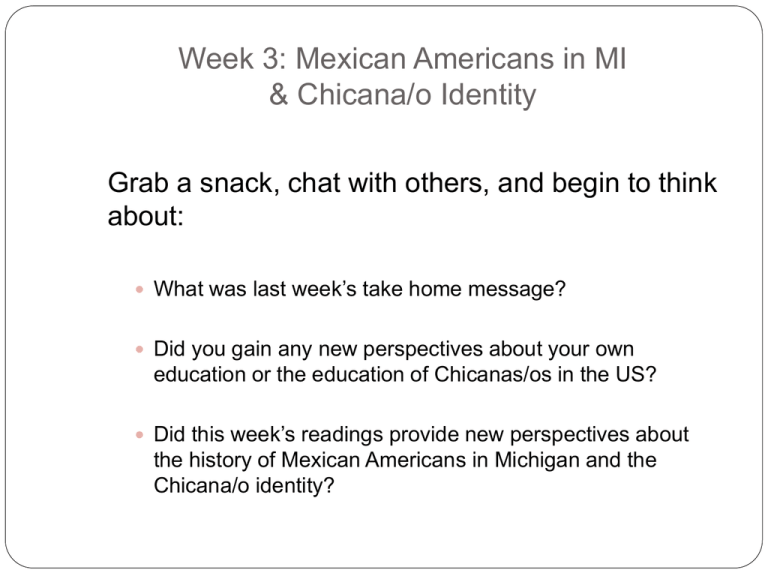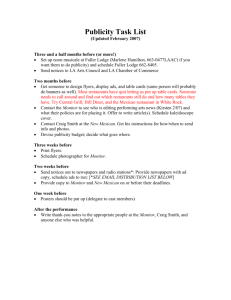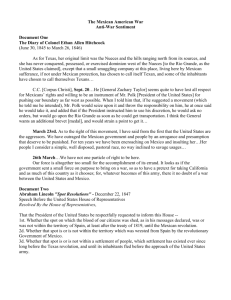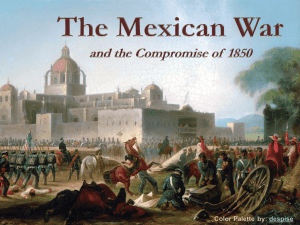ES 2000: Introduction to U.S. Education & Teaching Dr. Lucy
advertisement

Week 3: Mexican Americans in MI & Chicana/o Identity Grab a snack, chat with others, and begin to think about: What was last week’s take home message? Did you gain any new perspectives about your own education or the education of Chicanas/os in the US? Did this week’s readings provide new perspectives about the history of Mexican Americans in Michigan and the Chicana/o identity? Frameworks! Functionalism Conflict Theory Interpretive Critical Theory DIAGNOSE PREDICT UNDERSTAND EMANICPATE What are the characteristics of the dropout population? What are the social class origins of dropouts and at-risk students? How do the patterns of interaction between teachers and students lead students to define themselves as failures? What processes operate within the school to push students out? Essentialism Perennialism Progressivism Social Reconstruction Your Story Midwest Norteños Michiganders Migrants Our Stories Michigan:1900-1920s 1900: 56 Mexicans in Michigan 1920s: Women enter labor sector 1920: San Antonio, Texas was gateway to the Midwest Youth: Language brokers 1920 Census:1,268 BUT over 5,000 Mexicans in Detroit) Other cities: Saginaw, Flint, Pontiac, Port Huron, Battle Creek, Grand Rapids Sugar beet industry: Michigan Sugar, Continental Sugar, Isabella Sugar Auto industry: Ford & GM Railroads, Steel Mills (Briggs, Saginaw Grey Iron) 1910-1920 growth: WWI labor shortage, Henry Ford’s $5 day, Railroads, Post WWI economic boom Mostly men: Ages 20-29 1920-1940s Recession 1920-1921: Immigration sweeps or voluntary repatriation Detroit: Model for how to handle the “Mexican problem” in USA 1922 Economic Rebound: Ford, Buick, Chevy 1925: Mexican owned businesses and newspapers Evidence of cultural citizenship: Centro Cultura, Obreros Unidos Mexicanos, Circulo Mutualista Mexicano Great Depression: Voluntary repatriation and family separation (12,500 returned to Mexico) Late 1930s + 1940s: Increase of Mexican/Mexican American migration to Michigan Bracero Program Increase in cultural citizenship: Businesses, organizations, newspapers, Spanish language radio After 1950 1950: 25,000 Mexicans/ Mexican Americans in Detroit 1960s: Michigan was second to Texas in migrant farmworkers employed Higher Ed: Michigan State and University of Michigan (Mecha, Chispa, United Mexican American Students) Social Action: 1967 Detroit Riots March for Migrants Michigan chapter of La Raza Unida Party Committee of Concerned Spanish Speaking Americans (CCSSA) Latin Americans for Social & Economic Development (La Sed) 1980: 89,000 Julian Samora Research Institute 1990-2000: #15 in United States Activism: Affirmative action, immigration reform 2010: 436,000 Oral History: Saginaw, MI Purpose of study: To understand Mexican American wage labor, community formation, geographic links (local, regional, national) Methodology: Saginaw based newspapers, field reports from Bureau of Labor Statistics, 14 oral history interviews Let’s form three small discussion groups: 1. 2. 3. Factories in the fields The Mexican American industrial class Community building along the Saginaw River Make sure to discuss: Great Depression Discriminatory WWI & WWII Migratory networks Reasons/ motivations for migrating Sugar beet industry Recruitment strategies Repatriation Children/ youth Women Mexican colonies Impact on family life practices/policies Wage labor Residential segregation Diversity Educational system Community building Civic organizations Civil rights Border crossings Identity +Ideology/Issues + Imagination Chicanismo Politics of identity or political identity Identity: Race/ethnicity/male; outside of “the system” Ideology: Cultural nationalism/ Aztlan: Mexican Americans were neither Mexican nor American. Issues: Schools, political self determination, rights of farmworkers, land rights, Vietnam War, racial discrimination Imagination: Counter-narrative/ Chicano-centric narrative In your group, discuss Chicanismo and pose/write a discussion question that will engage the class in an more in-depth discussion of this political identity. Chicana/o Identity +Ideology/Issues + Imagination Xicanismo Politics of critical thinking Identity: Multidimensional and intersecting/ Transnational/ elastic; outside and inside of “the system” Ideology: Broader vision of social justice and human rights; alliance; coalition building Issues: Language, immigratio,n and connections to race/ethnicity Imagination: Willingness to critique our positions In your group, discuss Xicanismo and pose/write a discussion question that will engage the class in an more in-depth discussion of this transnational identity. CM Somos Familia Identity Critical consciousness Awareness of the role of power Result from various forms of oppression Social Justice Praxis ¿Qué me llevo? Take home message Discuss with peers : What did I gain from today’s conversation? What should I share with others? What should I research further?





